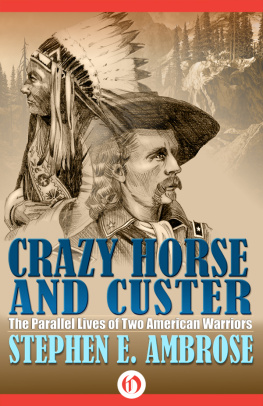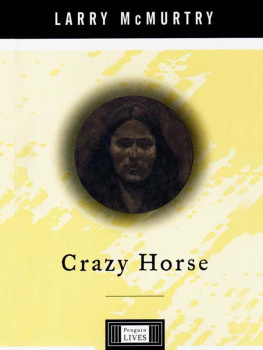This edition is published by BORODINO BOOKSwww.pp-publishing.com
To join our mailing list for new titles or for issues with our books borodinobooks@gmail.com
Or on Facebook
Text originally published in 1949 under the same title.
Borodino Books 2017, all rights reserved. No part of this publication may be reproduced, stored in a retrieval system or transmitted by any means, electrical, mechanical or otherwise without the written permission of the copyright holder.
Publishers Note
Although in most cases we have retained the Authors original spelling and grammar to authentically reproduce the work of the Author and the original intent of such material, some additional notes and clarifications have been added for the modern readers benefit.
We have also made every effort to include all maps and illustrations of the original edition the limitations of formatting do not allow of including larger maps, we will upload as many of these maps as possible.
CRAZY HORSE:
THE INVINCIBLE OGALALLA SIOUX CHIEF
The Inside Stories, by Actual Observers, Of a Most Treacherous Deed Against a Great Indian Leader
Edited and Arranged for Publication
BY
E. A. BRININSTOOL
Photos from a collection of E. A. Brininstool
INTRODUCTION
THE INSIDE STORY of the dastardly murder at old Fort Robinson, Nebraska, September 5, 1877, of Crazy Horse, the great fighting chief of the Sioux nation, is here given in full detail by military men who were present on that tragic occasion.
It adds one more blot to the outrageous treatment of the American Indian at the hands of the political parasites who composed the Indian ring at Washington.
General Jesse M. Leethan whom no better friend of the American Indian ever livedwas at that time Military Agent in charge of the Brule Sioux at Spotted Tail Agency, in North-western Nebraska. Major H. R. Lemly was a lieutenant of the Ninth Infantry, stationed at Camp Robinson, and Dr. V. T. McGillycuddy was Assistant Post Surgeon at that place, and attended Crazy Horse after the fatal stabbing until he passed away that same night. Private George McAnulty, Ninth Infantry, was an accidental witness to the killing of the chief, happening to be passing the guardhouse at the time. As four of the prominent spectators present, their stories teem with historic interest. The additional details supplied by Mrs. Lee, wife of General Lee, and their daughter, Mrs. Maude Lee Rethers, give an idea what the army women of that day were called upon to endure and witness.
Crazy Horse was one of the irreconcilables of the Sioux, an Indian who refused to be reconstructed and follow the white mans road. Like Sitting Bull he had little or no use for the white man, and especially those in authority at Washington. This is not surprising, considering the unjust treatment the Indian received, and the trickery and deceit practiced upon him.
Although but a young man, even at the time of his treacherous murder, Crazy Horse had already won his spurs in the defeat of Col. J. J. Reynolds in the Powder River fight of March 17, 1876, and of his practical defeat of General George Crooks forces in the Rosebud fight of June 17, 1876, to say nothing of the leading part he played in the annihilation of Custers immediate command o five troops of the Seventh Cavalry, June 25, 1876, at the battle of the Little Big Horn, in South-eastern Montana. After all these brilliant coups the reputation of Crazy Horse, as a fighting chief and wonderful leader and strategist, was secure among his own people.
Crazy Horse had come in and surrendered about the middle of the previous May, at Red Cloud Agency, with about 140 lodges of his people, numbering by actual count, around one thousand men, women and children, most of them being Ogalalla Sioux.
But Crazy Horse did not surrender because he himself wanted to. Far from it! He was by no means a subdued, humiliated and defeated warrior. He was actually starved out, and came in to make the best terms possible with the military authorities for his suffering people. He asked only for rest and peace for himself and his tribesmen.
In 1929 I gave the Nebraska Historical Society permission to publish in pamphlet form the accounts of General Lee and Dr. McGillycuddy. Later, Major H. R. Lemly generously sent me his own account of the Crazy Horse murder, and Private George McAnulty of the Ninth Infantry, also kindly furnished me with the facts of which he was an eyewitness, and which are included in the present edition, with Mrs. Lees and Mrs. Rethers interesting comments.
On September 5, 1934, there was unveiled at Fort Robinson, approximately on the site of the old guardhouse where Crazy Horse met his death, a fine stone monument (see frontispiece) in the form of a pyramid, with a brass tablet set into the stone work, which stated that Crazy Horse was A great chief of heroic character; he fought to the last to hold his native land for the Indian people. This was a fitting tribute to one of the very few great Indian generals of his time.
And now another great project is under way to further honor Chief Crazy Horse. This is to carve, in one of the huge mountains in the Black Hills of Dakota, an immense figure of an Indian chieftain, supposedly to represent Crazy Horse. This work is to be done by the son of Sculptor Borglum who carved figures of Presidents Lincoln and Theodore Roosevelt out of those mammoth hills a few years ago. From all reports it will take many years to complete this stupendous work; some reports say it will require 14 years, as this proposed figure to represent Crazy Horse will be more than twice the size of the others. Verily, the old adage seems to be true that Youve got to die to become famous. It certainly looks as though the former despised American Indian was at last coming into his own!
Crazy Horse was never photographed. He steadfastly refused to allow any pictures of himself to be taken. D. F. Barry, the noted photographer of Indian life, told me in 1926 he had repeatedly tried to bribe Crazy Horse to sit for his photograph, but the chief could not be bribed. It is regrettable that no photograph of this mighty warrior and great Sioux leader is in existence.












